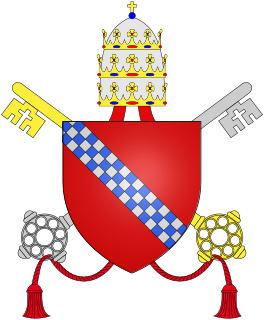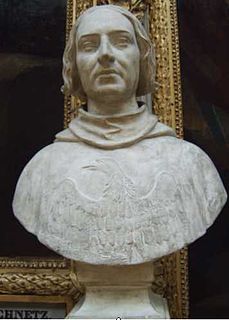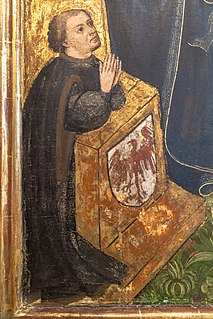 W
WPope Boniface IX was the Roman claimant to the headship of the Catholic Church from 2 November 1389 to his death. He was the second Roman pope of the Western Schism. During this time the Avignon claimants, Clement VII and Benedict XIII, maintained the Roman Curia in Avignon, under the protection of the French monarchy.
 W
WJean de Vienne was a French knight, general and Admiral of France during the Hundred Years' War.
 W
WEnguerrand VII de Coucy,, also known as Ingelram de Coucy and Ingelram de Couci, was a medieval French nobleman, and the last Lord of Coucy. He became son-in-law of King Edward III of England following his marriage to the king's daughter, Isabella of England, and the couple was subsequently granted by the king several English estates, among them the title Earl of Bedford. Coucy fought in the Battle of Nicopolis (1396) as part of a failed crusade against the Ottoman Empire, and was taken prisoner. Having contracted the bubonic plague, he died in captivity at Bursa, Ottoman Empire.
 W
WFrederick was the last Burgrave of Nuremberg from 1397 to 1427, Margrave of Brandenburg-Ansbach from 1398, Margrave of Brandenburg-Kulmbach from 1420, and Elector of Brandenburg from 1415 until his death. He became the first member of the House of Hohenzollern to rule the Margraviate of Brandenburg.
 W
WNicholas II Garai was a powerful Hungarian baron, who served as the Palatine of Hungary from 1402 until 1433 and the ban of Macsó, Usora, Só, Slavonia, Croatia and Dalmatia. He also ruled over Braničevo, Syrmia, Bačka, Banat and Baranya regions through vassals. Together with his close ally Stibor of Stiboricz, he became one of the richest and most powerful nobles in Hungary for over 30 years. The valiant Nicholas II Garai governed over national matters as the factual Ruler of Hungary next to the King Sigismund. In 1416 Sigismund extended their armorial bearings showing the Order of the Dragon and the Order of the Scarf. He presented the patent to his brother-in-law.
 W
WHermann II, Count of Celje, was a Styrian nobleman and magnate, most notable as the faithful supporter and father-in-law of the Hungarian king and Holy Roman Emperor Sigismund of Luxembourg. Hermann's loyalty to the King ensured him generous grants of land and privileges that led him to become the greatest landowner in Slavonia. He served as governor of Carniola, and twice as ban of the combined provinces of Slavonia, Croatia and Dalmatia, and was recognized by a treaty in 1427 as heir presumptive to the Kingdom of Bosnia. The House of Celje's rise to power culminated in achieving the dignity of Prince of the Holy Roman Empire. At the peak of his power, he controlled two thirds of the land in Carniola, most of Lower Styria, and exercised power over all of medieval Croatia. Hermann was one of the most important representatives of the House of Celje, having brought the dynasty from regional importance to the foreground of Central European politics.
 W
WJohn the Fearless was a scion of the French royal family who ruled the Burgundian State from 1404 until his death in 1419. He played a key role in French national affairs during the early 15th century, particularly in the struggles to rule the country for the mentally ill King Charles VI, his cousin, and the Hundred Years' War with England. A rash, ruthless and unscrupulous politician, John murdered the King's brother, the Duke of Orléans, in an attempt to gain control of the government, which led to the eruption of the Armagnac–Burgundian Civil War in France and in turn culminated in his own assassination in 1419.
 W
WKonrad Kyeser was a German military engineer and the author of Bellifortis, a book on military technology that was popular throughout the 15th century. Originally conceived for King Wenceslaus, Kyeser dedicated the finished work to Rupert of Germany.
 W
WJames II of Bourbon-La Marche was the first son of John I, Count of La Marche and Catherine of Vendôme.
 W
WStefan Lazarević, also known as Stefan the Tall, was the ruler of Serbia as prince (1389–1402) and despot (1402–1427). The son of Prince Lazar Hrebeljanović, he was regarded as one of the finest knights and military leaders at that time. After the death of his father at Kosovo (1389), he became ruler of Moravian Serbia and ruled with his mother Milica, until he reached adulthood in 1393. Stefan led troops in several battles as an Ottoman vassal, until asserting independence after receiving the title of despot from the Byzantines in 1402.
 W
WJean II Le Maingre, also known as Boucicaut, was a French knight and military leader. Renowned for his military skill and embodiment of chivalry, he was made a marshal of France.
 W
WLouis de Bourbon, called the Good, son of Peter de Bourbon and Isabella de Valois, was the third Duke of Bourbon.
 W
WMircea the Elder was the Voivode of Wallachia from 1386 until his death in 1418. He was the son of Radu I of Wallachia and brother of Dan I of Wallachia, after whose death he inherited the throne.
 W
WTommaso Mocenigo (1343–1423) was doge of the Republic of Venice from 1414 until his death.
 W
WPhilibert de Naillac was Grand Master of the Knights Hospitaller from 1396 until his death in Rhodes in 1421. Prior to his election he was Grand-Prior of Aquitaine.
 W
WPhilip of Artois, son of John of Artois, Count of Eu, and Isabeau of Melun, was Count of Eu from 1387 until his death, succeeding his brother Robert.
 W
WSigismund of Bohemia, also known as Sigismund of Luxembourg, was prince-elector of Brandenburg from 1378 until 1388 and from 1411 until 1415, king of Hungary and Croatia from 1387, king of Germany from 1411, king of Bohemia from 1419, king of Italy from 1431, and Holy Roman Emperor from 1433 until 1437, and the last male member of the House of Luxembourg.
 W
WStibor of Stiboricz of Ostoja was an aristocrat of Polish origin in the Kingdom of Hungary. He was a close friend of King Sigismund of Hungary who appointed him to several offices during his reign. For instance, between 1395 and 1401, then from 1409 to 1414 he was the Voivode of Transylvania. Stibor styled himself "Lord of the whole Vág", referring to his properties along the 409-km-long river where 15 of his 31 castles were situated.